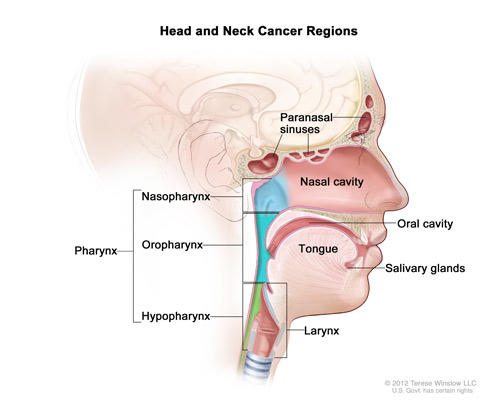Head and Neck Cancer
Head and neck cancer includes several types of cancers that affect your mouth, throat or other parts of your head and neck. The most common symptom is a persistent sore throat. You can reduce your risk by avoiding tobacco, limiting alcohol and getting the HPV vaccine. These cancers are often treatable if caught early, and most are preventable.
Types of head and neck cancers
Head and neck cancers include cancers in your mouth, parts of your throat (nasopharynx, oropharynx and hypopharynx) and other related structures:
- Oral cancer: Cancer that forms in your lips, gums, tongue, the lining of your cheeks and lips, the top and bottom of your mouth, or behind your wisdom teeth.
- Salivary gland cancer: Cancer of your salivary glands, which produce spit.
- Nasal cavity and paranasal sinus cancer: Cancer that forms in the hollow area inside of your nose (nasal cavity) or the hollow spaces in the bones surrounding your nose (paranasal sinuses).
- Nasopharyngeal cancer: Cancer of the upper part of your throat (nasopharynx).
- Oropharyngeal cancer: Cancer of the middle part of your throat (oropharynx), including your tonsils and the base of your tongue.
- Hypopharyngeal cancer: Cancer of the bottom part of your throat (hypopharynx).
- Laryngeal cancer: Cancer of your voice box (larynx), which contains your vocal cords.
How common are head and neck cancers?
About 4.5% of cancer diagnoses worldwide are head and neck cancers. Most head and neck cancers affect males over 50. But this may be because this group is more likely to have risk factors associated with these cancers, like a history of tobacco use.
In the U.S., instances of tobacco-related head and neck cancers have fallen. Head and neck cancers related to HPV (a type of sexually transmitted infection) are on the rise. Alongside this shift, more people getting diagnosed are under 50.
Symptoms and Causes
Head and neck cancers typically form in the squamous cells lining various regions of your head and neck.
What are the symptoms of head and neck cancer?
Head and neck cancer symptoms are often mild. They can mimic less serious conditions like a cold or sore throat. A sore throat that doesn’t get better is the most common sign of head and neck cancer.
Depending on the type of head and neck cancer, you may experience:
- A persistent sore throat
- Persistent earaches or symptoms of ear infections
- Frequent headaches
- Pain in your face or neck that won’t go away
- Pain in your upper teeth
- Pain when you chew or swallow
- Hoarseness or voice changes
- Trouble breathing or speaking
You may notice:
- A lump in your throat, mouth or neck
- A mouth or tongue sore that doesn’t heal
- Frequent nosebleeds, bloody saliva or phlegm
- A white or red patch on your gums, tongue or inside your mouth
- Swelling in your jaw, neck or side of your face
Check with a healthcare provider immediately if you notice any of these symptoms. They may be signs of something less serious, but you’ll need a thorough exam to be sure.
What causes head and neck cancer?
Head and neck cancer starts when a normal cell turns malignant and begins to replicate uncontrollably. These cells form a tumor that can invade nearby tissue and spread throughout the body (metastasize).
Risk factors for head and neck cancer
The most common risk factors include:
- Tobacco use: Responsible for 70% to 80% of cases globally.
- Alcohol consumption: Especially harmful when combined with tobacco use.
- HPV infection: Becoming the leading risk factor in many developed countries.
- Betel nut chewing: Common in Southern and Southeast Asia, and Polynesia.
Other contributing factors:
- Epstein-Barr virus (EBV): Linked to nasopharyngeal and salivary gland cancers.
- Weakened immune system: Due to HIV or major surgeries like transplants.
- Genetics: Conditions like Fanconi anemia can increase risk.
- Exposure to carcinogens: Such as asbestos, wood dust, and paint fumes.
- Radiation exposure: Prior radiation therapy to head and neck.
- Salt-cured foods: Increase risk of nasopharyngeal cancer.
- Poor oral hygiene: Linked to increased oral cancer risk.
Diagnosis and Tests
How are head and neck cancers diagnosed?
Diagnosis usually begins with a physical exam. A healthcare provider will examine your mouth, nasal cavity, throat and neck for unusual growths or swelling.
Further tests may include:
- Endoscopy: Uses a lighted tube to examine your nasal cavity, throat or voice box.
- Imaging tests: X-rays, CT scans, MRIs, or PET scans to detect tumors.
- Lab tests: HPV testing if applicable.
- Biopsy: The only definitive way to confirm cancer by analyzing tissue samples.




